Madonna is a pivotal figure in popular culture, renowned for her ability to reinvent herself throughout her career, which spans several decades. This article examines the significance of her reinvention, highlighting key milestones, the evolution of her musical styles, and her impact on gender and sexuality in music. It also explores how her strategies for adaptation, including collaboration and social media engagement, have allowed her to remain relevant in the ever-changing music industry. Additionally, the article discusses the themes she addresses in her work, her influence on other artists, and the lessons individuals can learn from her approach to resilience and self-reinvention.
What is the significance of Madonna’s reinvention in popular culture?
Madonna’s reinvention is significant in popular culture as it exemplifies the power of adaptability and self-reinvention in the music industry. Throughout her career, she has consistently transformed her image and sound, influencing trends and challenging societal norms. For instance, her shift from the pop icon of the 1980s to the provocative figure in the 1990s with albums like “Erotica” showcased her ability to push boundaries and engage with contemporary issues such as sexuality and identity. This adaptability has not only maintained her relevance but has also inspired countless artists to embrace change and innovation in their own careers. Madonna’s impact is evident in the way she has shaped the landscape of pop music, encouraging a culture that values artistic evolution and personal expression.
How has Madonna’s career evolved over the decades?
Madonna’s career has evolved significantly over the decades, marked by her ability to reinvent herself and adapt to changing musical landscapes. In the 1980s, she emerged as a pop icon with hits like “Like a Virgin” and “Material Girl,” establishing her as a provocative figure in music and fashion. The 1990s saw her experimentation with different genres, including the release of the critically acclaimed album “Ray of Light,” which incorporated electronic music and spirituality, earning her a Grammy Award.
In the 2000s, Madonna continued to push boundaries with albums like “Confessions on a Dance Floor,” which showcased her dance-pop roots and solidified her status as a dance music pioneer. The 2010s marked a return to more personal themes in her work, as seen in albums like “MDNA” and “Rebel Heart,” reflecting her experiences and challenges. Throughout her career, Madonna has consistently embraced new technologies and platforms, from music videos to social media, ensuring her relevance in the industry. Her ability to adapt and innovate has not only sustained her career but also inspired countless artists across generations.
What key milestones mark Madonna’s journey of reinvention?
Key milestones that mark Madonna’s journey of reinvention include her debut album “Madonna” in 1983, which established her as a pop icon, and the release of “Like a Virgin” in 1984, which solidified her provocative image. In 1990, her “Blonde Ambition World Tour” showcased her theatrical performances and challenged societal norms. The 1998 album “Ray of Light” marked a significant shift towards electronic music and spirituality, earning her critical acclaim. In 2003, her collaboration with Britney Spears at the MTV Video Music Awards symbolized her ability to remain relevant across generations. Each of these milestones reflects Madonna’s continuous evolution as an artist and cultural figure.
How have her musical styles changed throughout her career?
Madonna’s musical styles have evolved significantly throughout her career, transitioning from pop and dance music in the 1980s to incorporate elements of electronic, rock, and even world music in later decades. Initially, her debut album “Madonna” (1983) showcased a dance-pop sound, characterized by catchy hooks and synthesizers. As her career progressed, albums like “Ray of Light” (1998) introduced a more electronic and ambient sound, reflecting influences from techno and trip-hop. Additionally, her 2003 album “American Life” featured a blend of folk and hip-hop elements, showcasing her willingness to experiment with diverse genres. This evolution illustrates her adaptability and commitment to artistic reinvention, which has kept her relevant in the music industry for decades.
Why is Madonna considered a cultural icon?
Madonna is considered a cultural icon due to her significant influence on music, fashion, and social issues over several decades. She revolutionized the music industry with her innovative approach to pop music, blending various genres and pushing boundaries with her provocative lyrics and performances. Her ability to reinvent herself, as seen in her evolving musical styles and public personas, has kept her relevant in popular culture since the 1980s. Additionally, Madonna has addressed important social issues, such as gender equality and LGBTQ+ rights, using her platform to advocate for change. Her impact is evidenced by her numerous awards, including multiple Grammy Awards, and her induction into the Rock and Roll Hall of Fame, solidifying her status as a transformative figure in entertainment.
What impact has Madonna had on gender and sexuality in music?
Madonna has significantly impacted gender and sexuality in music by challenging traditional norms and promoting sexual liberation. Through her provocative lyrics, bold fashion choices, and public persona, she has redefined femininity and empowered women to express their sexuality openly. For instance, her 1984 hit “Like a Virgin” sparked discussions about female sexuality and agency, while her 1990 “Justify My Love” music video, which featured same-sex relationships, pushed boundaries regarding LGBTQ+ representation in mainstream media. Madonna’s influence is evident in the way contemporary artists embrace sexual expression and gender fluidity, reflecting her legacy in reshaping societal attitudes towards these topics.
How has her influence shaped the careers of other artists?
Madonna’s influence has significantly shaped the careers of other artists by setting a precedent for reinvention and self-expression in the music industry. Many contemporary artists, such as Lady Gaga and Beyoncé, have cited her as a major inspiration for their own artistic evolution and willingness to challenge societal norms. For instance, Lady Gaga’s theatrical performances and bold fashion choices echo Madonna’s pioneering approach to blending music with visual art, demonstrating how Madonna’s legacy encourages artists to explore their identities and push creative boundaries. Additionally, Madonna’s ability to adapt to changing musical landscapes has inspired artists to embrace versatility, as seen in the diverse genres and styles adopted by modern pop stars.

What are the strategies Madonna employs for reinvention?
Madonna employs several key strategies for reinvention, including constant evolution of her musical style, collaboration with diverse artists, and embracing new technologies. By frequently changing her musical genres—from pop to electronic to experimental—she keeps her sound fresh and relevant. Collaborating with a wide range of artists, such as Nicki Minaj and Justin Timberlake, allows her to tap into different audiences and trends. Additionally, Madonna utilizes social media and digital platforms to engage with fans and promote her work, ensuring her presence remains strong in the ever-changing music landscape. These strategies have enabled her to maintain a prominent position in the entertainment industry for decades.
How does Madonna stay relevant in the ever-changing music industry?
Madonna stays relevant in the ever-changing music industry by continuously evolving her musical style and embracing new technologies. She has successfully adapted to shifts in popular music trends, incorporating elements from various genres and collaborating with contemporary artists, which keeps her sound fresh and appealing. For instance, her 2019 album “Madame X” featured a blend of pop, Latin, and experimental sounds, showcasing her ability to innovate while still appealing to a broad audience. Additionally, Madonna utilizes social media platforms effectively to engage with fans and promote her work, ensuring her presence remains strong in the digital age. This strategic approach to reinvention and engagement has solidified her status as a lasting icon in the music industry.
What role does collaboration play in her reinvention process?
Collaboration is essential in Madonna’s reinvention process as it allows her to blend diverse artistic influences and perspectives. By working with various producers, songwriters, and artists, she continually evolves her sound and image, ensuring relevance in the ever-changing music industry. For instance, her partnerships with contemporary artists like Nicki Minaj and Diplo have introduced fresh elements to her work, demonstrating how collaboration fuels her creative growth and adaptability. This strategic engagement with others not only enhances her artistic output but also reinforces her status as a cultural icon capable of reinventing herself across decades.
How does she utilize social media to connect with her audience?
Madonna utilizes social media to connect with her audience by actively engaging with fans through platforms like Instagram, Twitter, and Facebook. She shares personal insights, behind-the-scenes content, and interactive posts that encourage audience participation, such as polls and Q&A sessions. This approach fosters a sense of community and intimacy, allowing her to maintain relevance and strengthen her brand. For instance, her Instagram account features a mix of promotional content and personal reflections, which has garnered millions of followers and high engagement rates, demonstrating her effectiveness in using social media as a tool for connection.
What themes does Madonna explore in her reinventions?
Madonna explores themes of identity, sexuality, empowerment, and social commentary in her reinventions. Throughout her career, she has consistently challenged societal norms, using her music and image to address issues such as gender roles and sexual freedom. For instance, her 1990 “Like a Prayer” album incorporated religious imagery to provoke discussions about faith and sexuality, while her 2012 “MDNA” album reflected on personal struggles and resilience. These themes not only showcase her artistic evolution but also resonate with audiences, reinforcing her status as a cultural icon.
How does she address social issues through her music and persona?
Madonna addresses social issues through her music and persona by incorporating themes of gender equality, LGBTQ+ rights, and social justice into her lyrics and public image. For instance, her song “Express Yourself” promotes female empowerment and challenges traditional gender roles, while her advocacy for LGBTQ+ rights is evident in her support for marriage equality and her participation in pride events. Additionally, her music videos often feature provocative imagery that critiques societal norms, such as in “Like a Prayer,” which addresses racial and religious tensions. These elements demonstrate her commitment to using her platform to raise awareness and inspire change regarding pressing social issues.
What personal experiences influence her artistic transformations?
Madonna’s artistic transformations are significantly influenced by her personal experiences, including her upbringing in Michigan, her struggles with identity, and her relationships. Growing up in a Catholic household, she faced strict religious expectations, which shaped her rebellious artistic persona. Additionally, her experiences in New York City during the 1980s, where she navigated the music and art scenes, fueled her creativity and desire for reinvention. Her relationships, particularly with influential figures in the music industry, have also played a crucial role in her evolution as an artist, allowing her to explore various genres and styles. These experiences collectively inform her ability to adapt and innovate, making her a lasting icon in the music industry.

How does Madonna inspire others through her journey?
Madonna inspires others through her journey by exemplifying resilience and adaptability in her career. Throughout her decades-long career, she has consistently reinvented her musical style and public persona, demonstrating that evolution is essential for longevity in the entertainment industry. For instance, her ability to transition from pop icon to a figure of social activism, particularly in advocating for LGBTQ+ rights and women’s empowerment, showcases her commitment to using her platform for positive change. Additionally, her 2019 album “Madame X” reflects her willingness to explore new artistic directions, further inspiring others to embrace change and authenticity in their own lives.
What lessons can be learned from Madonna’s approach to reinvention?
Madonna’s approach to reinvention teaches the importance of adaptability and continuous evolution in one’s career. By consistently changing her musical style, image, and public persona, Madonna has remained relevant across decades, demonstrating that embracing change can lead to sustained success. For instance, her transitions from pop to electronic music and her bold fashion choices have not only captivated audiences but also influenced cultural trends. This adaptability is supported by her ability to engage with contemporary issues, such as gender and sexuality, which keeps her work resonant with new generations. Thus, the key lessons from Madonna’s reinvention are the necessity of flexibility, the courage to take risks, and the value of staying connected to societal changes.
How can individuals apply her strategies to their own lives?
Individuals can apply Madonna’s strategies to their own lives by embracing adaptability and continuous self-reinvention. By regularly assessing their personal and professional goals, individuals can identify areas for growth and change, similar to how Madonna has evolved her music and image over decades. Research indicates that adaptability is linked to resilience and success; for instance, a study published in the Journal of Personality and Social Psychology found that individuals who embrace change are more likely to achieve their goals. Therefore, by adopting a mindset of flexibility and openness to new experiences, individuals can effectively implement Madonna’s strategies in their own lives.
What role does resilience play in her story of reinvention?
Resilience is a fundamental aspect of Madonna’s story of reinvention, enabling her to adapt and thrive in an ever-changing music industry. Throughout her career, she has faced numerous challenges, including public scrutiny and evolving musical trends, yet her ability to bounce back and reinvent her image and sound has solidified her status as a cultural icon. For instance, after facing backlash for her provocative performances in the 1980s, Madonna transformed her artistic expression, embracing new genres and collaborations, which allowed her to maintain relevance and influence. This capacity for resilience not only showcases her determination but also serves as an inspiration for others seeking to navigate their own paths of reinvention.
What are some practical tips for embracing reinvention like Madonna?
To embrace reinvention like Madonna, focus on continuous self-evolution, adaptability, and boldness in exploring new artistic directions. Madonna has consistently reinvented her image and sound, demonstrating the importance of staying relevant by experimenting with different genres and styles, such as transitioning from pop to electronic music in her albums like “Ray of Light.” Additionally, she emphasizes the value of resilience; despite facing criticism, she remains unapologetic about her choices, showcasing the need for confidence in one’s vision. Engaging with diverse influences, whether through collaborations or cultural exploration, further enriches the reinvention process, as seen in her work with various artists across genres.
How can one cultivate a mindset open to change and growth?
To cultivate a mindset open to change and growth, one must actively embrace challenges and view failures as opportunities for learning. Research indicates that individuals who adopt a growth mindset, as defined by psychologist Carol Dweck, are more likely to achieve success because they believe their abilities can be developed through dedication and hard work. This perspective encourages resilience and adaptability, essential traits for navigating change. Engaging in continuous learning, seeking feedback, and surrounding oneself with supportive individuals further reinforce this mindset, enabling personal and professional growth.
What steps can be taken to explore new creative avenues?
To explore new creative avenues, individuals can engage in diverse experiences, such as traveling to new locations, collaborating with different artists, or experimenting with various art forms. These activities stimulate inspiration and broaden perspectives, which are essential for creativity. For instance, Madonna has consistently reinvented her artistic style by collaborating with various producers and artists across genres, showcasing the effectiveness of collaboration in fostering creativity. Additionally, research indicates that exposure to new environments can enhance creative thinking, as demonstrated in studies published in the Journal of Personality and Social Psychology, which found that diverse experiences contribute to innovative problem-solving.



